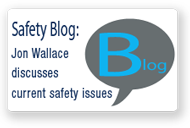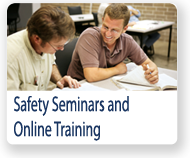“I learned a great deal that I will be able to apply... Thanks for a very informative, effective training session (30-Hour Complying with OSHA).” 

Join our Mailing List: |
Safety ArticlesPerforming the Personal Protective Equipment (PPE) Hazard AnalysisBy W. Jon Wallace, CSP, MBA * This article was published the December 2005 issue of Occupational Health & Safety Magazine. Thousands of people are blinded each year from work-related eye injuries that could have been prevented with the proper selection and use of eye and face protection. Eye injuries alone cost more than $300 million per year in lost production time, medical expenses, and worker compensation. (Source: Occupational Safety and Health Administration) Failure to adequately assess the workplace for potential hazards and identify appropriate personal protective equipment (PPE) not only results in thousands of eye injuries each year, it is also responsible for numerous injuries to the hands and arms, torso, feet, and head. PPE Hazard AssessmentTo ensure employees wear appropriate PPE for their works tasks, OSHA 29 CFR 1910.132 (d)(1) requires employers perform a PPE assessment to determine if hazards are present, or likely to be present, that necessitate the use of personal protective equipment. In addition, 29 CFR 1910.132 (d)(2) requires a written certification of the assessment. Hierarchy of ControlsA systematic review of each work task is needed to identify potential hazards. Prior to requiring employees to wear PPE, however, the hierarchy of controls should be utilized to eliminate or reduce the existing hazard(s) to avoid the need for PPE. The hierarchy of controls states that hazards should be controlled in this preference:
PPE should be selected only after the first four options have been evaluated and found to be infeasible. Personal Protective Equipment for Various ExposuresOnce the hazard assessment is complete, appropriate PPE must be selected. Listed below is a summary of typical PPE for various work tasks based upon National Safety Council, OSHA, and ANSI requirements and recommendations.
Who Pays for PPE?During training classes, I am routinely asked whether OSHA requires employers to pay for employee PPE. In an OSHA letter of Interpretation dated August 25, 2004, addressed to Mr. Brad Milleson of the Kellogg Company, OSHA states the following: “29 CFR 1910.132 requires employers to provide PPE and ensure its use. However, at the present time, OSHA does not view this section as imposing an enforceable obligation on employers to pay for PPE. Therefore, employees must be afforded the protection of PPE, regardless of who pays.” OSHA has initiated rulemaking proceedings to clarify who is required to pay for required PPE. It is important to note that there are numerous OSHA standards that specifically require the employer provide PPE at no cost to the employee. Those standards include: Occupational Noise Exposure (1910.95); Respiratory Protection (1910.134); Permit-Required Confined Spaces (1910.146); Fire Brigades (1910.156); Logging Operations (1910.266); Asbestos (1910.1001); Inorganic Arsenic (1910.1018); Lead (1910.1025); Cadmium (1910.1027); Benzene (1910.1028); Bloodborne Pathogens (1910.1030); 1,2-dibromo-3-chloropropane (1910.1044); Acrylonitrile (1910.1045); Ethylene Oxide (1910.1047); Formaldehyde (1910.1048); Methylenedianiline (1910.1050); 1,3-Butadiene (1910.1051); and Methylene Chloride (1910.1052). Apparel PolicyAn apparel policy should be included in the PPE procedure. Loose clothing should be prohibited around rotating equipment and long hair should be tucked under the collar or secured with a hair net. Rings, necklaces, and gloves should not be worn while working around rotating equipment as they may become entangled in the equipment. SummaryUsed properly, PPE provides a significant increase in protection for employees. The key components include a documented hazard assessment, employee training as well as periodic inspections to verify program effectiveness.
If you have any questions concerning this article or other safety issues, please contact W. Jon Wallace, "The Safety Guru", at 919.933.5548 or by |
||||||||||||||||||||||||||||||||||||||||||||||||||||||||||||||||||||||||||||||||||||||||||||||||||||||||||||||||||||||||||||||||||||||||||||||